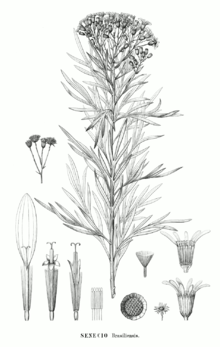Senecio brasiliensis
Senecio brasiliensis, known by the common name flor-das-almas,[1] (flower-of-souls), is a perennial species of the genus Senecio and family Asteraceae. It is native to fields and meadows of central South America.
| Senecio brasiliensis | |
|---|---|
 | |
| flor-das-almas | |
| Scientific classification | |
| Kingdom: | Plantae |
| Clade: | Tracheophytes |
| Clade: | Angiosperms |
| Clade: | Eudicots |
| Clade: | Asterids |
| Order: | Asterales |
| Family: | Asteraceae |
| Genus: | Senecio |
| Species: | S. brasiliensis |
| Binomial name | |
| Senecio brasiliensis (Spreng.) Less. | |
 | |
| Native range of S. brasiliensis. | |
| Synonyms | |
|
Cineraria brasiliensis Spreng.[1] | |
Description
S. brasiliensis is a densely leafy perennial herb, 1 metre (3.3 ft) to 2 metres (6.6 ft) tall, with yellow flowers that prefers to make its home in degraded pasture lands and unploughed croplands in central South America.[3][4]
Leaves and stems: S. brasiliensis stands very upright with a branched hairless and grooved stem. The leaves are alternate, pinnate and deeply lobed[4] dark green on the top, whitish green on the underside.[5] The lower part of the plant is smooth, while the upper part is hairy and the leaves cluster at the highest point with the flower stalks (corymbs).[4]
Flowers: Yellow flowers dense on corymbs; two types of flowers (that look like [petal]s), disc florets with both male and female flowers and ray flowers which are simply female.[4]
Seeds: Small seed with white hairs that use the wind to get around with.[4]
Common Names
- English: Flower of souls, hempleaf ragwort
- Portuguese: malmequer-amarelo, Maria-mole, tasneirinha, flor-das-almas[1][4][5][6]
- Guarani: Agosto poty (August flower)
 growing in Rio Grande do Sul
growing in Rio Grande do Sul
Distribution
S. brasiliensis grows at elevations of 0 metres (0 ft) to 1,000 metres (3,300 ft).
Native: Argentina (mostly North Argentine Northwest and Gran Chaco), Bolivia, Brazil (mostly South Central), Paraguay, and Uruguay.[1][2][4][6]
Current:
Predators
- Phaedon confinis (Chrysomelidae)[3]
- Atarsocoris brachiariae (Hemiptera: Cydnidae) – Burrowing brown bug[7]
References
- "Senecio brasiliensis". Germplasm Resources Information Network (GRIN). Agricultural Research Service (ARS), United States Department of Agriculture (USDA). Retrieved 5 March 2008.
- Instituto Darwinion. "Asteraceae". Catálogo de las Plantas Vasculares de la República Argentina. II (in Spanish). Universidad de Buenos Aires. pp. 184, 188. Archived from the original (PDF) on 13 December 2007. Retrieved 5 March 2008.
- Michelli Maria Mendes; Maysa de Lima Leite; Geovan Henrique Corrêa; Julianne Milléo (20 April 2005). "ENTOMOFAUNA ASSOCIATED WITH SENECIO BRASILIENSIS LESS (ASTERACEAE), AND PHAEDON CONFINIS (INSECTA; COLEOPTERA; CHRYSOMELIDAE) AS A POSSIBLE CONTROLLER AGENT OF THIS TOXIC PLANT" (PDF) (in Portuguese). Retrieved 5 March 2008.
Phaedon confinis Klug, 1829 (Chrysomelidae) was the one that most stood out, specially because it was found in great numbers on the plant
- Claudio Barros; Elissa Totin; Raquel Rech; Marcia Ilha; Steve Valeika (March 2001). "Senecio spp". Lista de Plantas (in Portuguese). Universidade Federal de Santa Maria. Archived from the original on 21 February 2008. Retrieved 5 March 2008.
- Centro de Informação Toxicológica do Rio Grande do Sul. "Senecio brasiliensis Less. – Maria-mole" (in Portuguese). Retrieved 6 March 2008.
- Natural Resources Conservation Service (NRCS). "PLANTS Profile, Senecio cannabinifolius Hook. & Arn". The PLANTS Database. United States Department of Agriculture. Retrieved 6 March 2008.
- Oliveira Émerson D.M. de, Pasini Amarildo, Fonseca Inês C.B., ÉMerson D.M. de; Pasini, Amarildo; Fonseca, Inês C.B. (January 2003). "Association of the soil bug Atarsocoris sp. (Hemiptera: Cydnidae) with the weed Senecio brasiliensis Less". Neotropical Entomology. Sociedade Entomológica do Brasil. 32 (1): 155–157. doi:10.1590/S1519-566X2003000100024. 1519566X.CS1 maint: multiple names: authors list (link)
External links
![]()
![]()
- "Senecio cannabinifolius". Integrated Taxonomic Information System. Retrieved 6 March 2008.
- "Herbarium record". Neotropical Herbarium Specimens. fieldmuseum.org. Retrieved 22 April 2008.
- Gustavo H. Shimizu (30 September 2006). "Image of Senecio brasiliensis". Retrieved 6 March 2008.